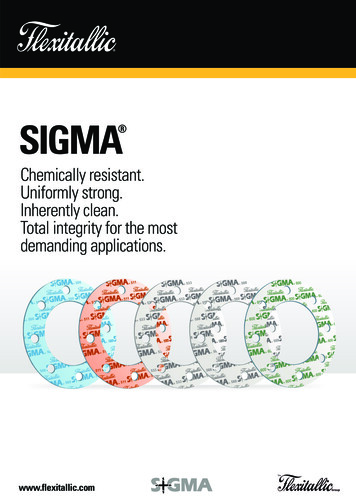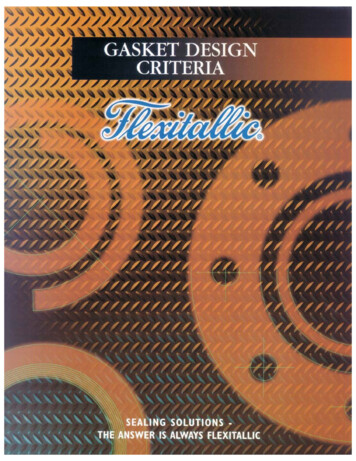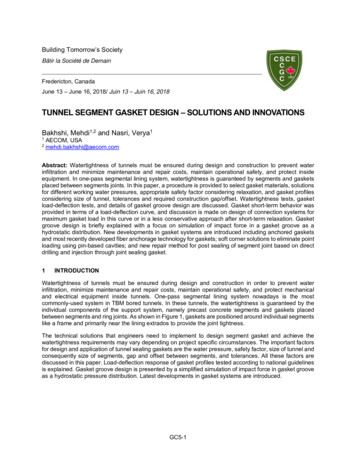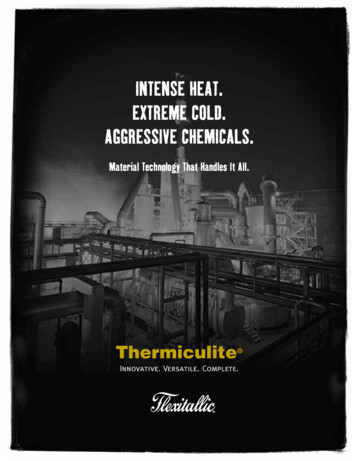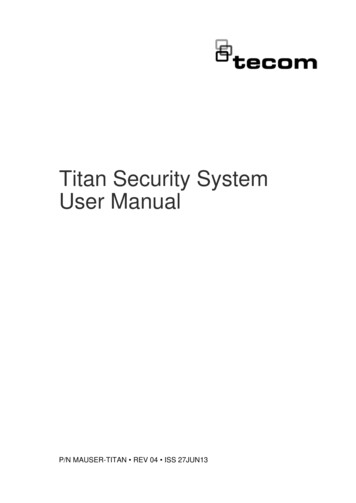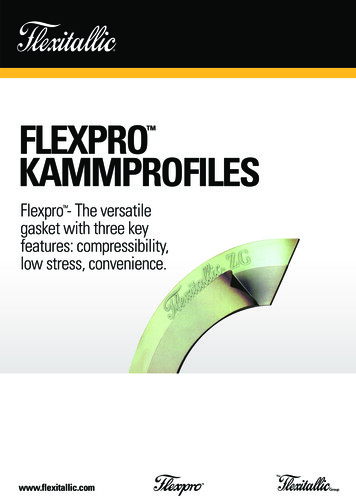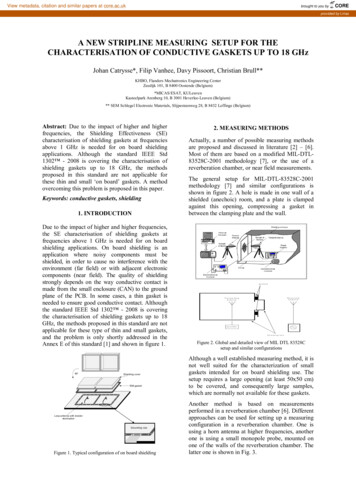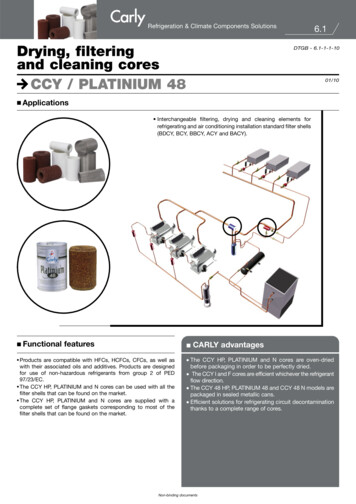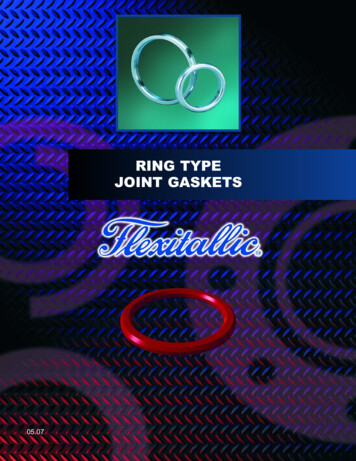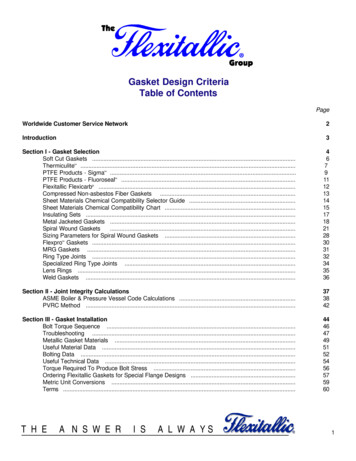
Transcription
Gasket Design CriteriaTable of ContentsPageWorldwide Customer Service Network2Introduction3Section I - Gasket SelectionSoft Cut Gaskets .Thermiculite .PTFE Products - Sigma .PTFE Products - Fluoroseal .Flexitallic Flexicarb .Compressed Non-asbestos Fiber Gaskets .Sheet Materials Chemical Compatibility Selector Guide .Sheet Materials Chemical Compatibility Chart .Insulating Sets .Metal Jacketed Gaskets .Spiral Wound Gaskets.Sizing Parameters for Spiral Wound Gaskets .Flexpro Gaskets .MRG Gaskets .Ring Type Joints .Specialized Ring Type Joints .Lens Rings .Weld Gaskets .4679111213141517182128303132343536Section II - Joint Integrity CalculationsASME Boiler & Pressure Vessel Code Calculations .PVRC Method .373842Section III - Gasket InstallationBolt Torque Sequence .Troubleshooting .Metallic Gasket Materials .Useful Material Data .Bolting Data .Useful Technical Data .Torque Required To Produce Bolt Stress .Ordering Flexitallic Gaskets for Special Flange Designs .Metric Unit Conversions .Terms .4446474951525456575960T H EA N S W E RI SA L W A YS 1
Worldwide Customer Service NetworkOwned ManufacturingPlantsLicenseesACL Specialised Gaskets Pty. Ltd.Brisbane, AustraliaTel: 61 73 268 0666Flexitallic Ltd.Cleckheaton,Yorkshire, UKTeI: 44 1274 851273Flexitallic Ltd.Rochdale, Lancashire, UKTeI: 44 1274 851273AGS Group Inc.Edmonton, Alberta, CanadaTel: 1 780 466 5050Flexitallic L.P.Houston,Texas, USATel: 1 281 604 2400Arne Bo PedersenStavanger, NorwayTel: 47 5185 9000Flexitallic CanadaOntario, CanadaTel: 1 519 332 8300Automotive Components N.Z.Auckland, New ZealandTel: 64 98284119Joint VenturesDragon Industrial ServicesPembroke, UKTel: 441646 622200Equiter S.A. de C.V.Guadalajara, MexicoTel: 52 3 612 8483Eriks BV.Rotterdam, NetherlandsTel: 31 72 514 1514Flexitallic de Venezuela S.A.Caracas,VenezuelaTeI: 58 2 41 783550FMI Sima S.R.L.Brescia, ItalyTel: 39 030 7386 033Goldcrest Engineering & Service Co.(GESCO)Pataya, Chonburi, ThailandTel: 1 66 38 716 716Branch Offices & WarehousesFlexitallic Ltd.Aberdeen, Scotland, UKTel: 44 1224 725241Henry Gallacher Ltd.Stockton, Teesside UKTel: 44 1642 750111Flexitallic GmbHBurscheid, GermanyTel: 49 2174 8950Industrial Gasket & SupplyTorrance, California,USATel: 1 310 530 1771Flexitallic L.P.Cherry Hill, New Jersey, USATel: 1 856 321 9301Lake Charles RubberLake Charles, Louisiana, USATel: 1 337 433 1002Flexitallic L.P.Chicago, Illinois, USATel: 1 630 268 0418Saudi Gasket FactoryJeddah, Saudi ArabiaTel: 996 2 665 2966Flexitallic Ltd.Singapore 048581Tel: 65 6 321 91122T H EA N S W E RI SA L W A YS
FLEXITALLIC GASKET DESIGN CRITERIAIntroductionFLEXITALLIC, the world’s leading manufacturer and supplier of static seals and the originator of the Spiral Wound Gasket, iscommitted to sealing solutions for today’s industry. With greater emphasis than ever before placed on joint tightness, more attention is focused toward variables associated with the integrity of the bolted gasketed joint. Flexitallic Gasket Design Criteria manual offers the engineer and end user assistance in meeting the goal of providing fundamentally sound static sealing practice.Developed and collated by Flexitallic’s worldwide team of engineers, this publication is the “engineer’s handbook” of static sealstechnology.Flexitallic has identified three factors which must be considered to achieve a leaktight joint Gasket Selection Gasket Design Gasket InstallationThe GasketA gasket is a compressible material, or a combination of materials, which when clampedbetween two stationary members prevents the passage of the media across those members.The gasket material selected must be capable of sealing mating surfaces, resistant tothe medium being sealed, and able to withstand the application temperatures and pressures.Overcoming Flange ImperfectionsScoringsDistortiontroughHow Does It Work?A seal is effected by the action of force upon the gasket surface. This force which compresses the gasket, causes it to flow into the flange macro and micro imperfections. Thecombination of contact stress, generated by the applied force between the gasket and theflange, and the densification of the gasket material, prevents the escape of the confined fluidfrom the llelFlange ImperfectionsOn seating, the gasket must be capable of overcoming the macro and micro imperfections.Macro defects are imperfections such as flange distortions, non-parallelism, scoring,troughs, while superficial imperfections such as minor scratches and minor scores are considered micro imperfections.BoltLoadHydrostaticEnd ForceForces On The GasketIn order to ensure the maintenance of the seal throughout the life expectancy of the assembly, sufficient stress must remain on the gasket surface to prevent leakage. The residual boltload on the gasket should at all times be greater than the hydrostatic end force acting againstit.The hydrostatic end force is the force produced by the internal pressure which actsto separate the flanges.Blow OutForceGasketConsiderations For Gasket SelectionsMany factors should be considered when selecting a gasket to ensure its suitability for theintended application. Gasket properties as well as flange configuration and applicationdetails are part of the selection process.T H EA N S W E RI SA L W A YSInternal Pressure is exertedagainst both the flange and thegasket. 3
SECTION IGasket SelectionGaskets can be classified into three categories: soft cut, semi-metallic and metallic types.The physical properties and performance of a gasket will vary extensively, depending on the type of gasket selected and thematerials from which it is manufactured.Physical properties are important factors when considering gasket design and the primary selection of a gasket type is based onthe following: Temperature of the media to be contained Pressure of the media to be contained Corrosive nature of the application Criticality of the applicationSoft CutSheet materials are used in low to medium pressure services. With careful selection thesegaskets are not only suitable for general service but also for extreme chemical services andtemperatures.Types: Non-asbestos Fiber Sheets, PTFE, Biaxially Orientated Reinforced PTFE, Graphite,Thermiculite, Insulating Gaskets.Semi-metallicThese are composite gaskets consisting of both metallic and non-metallic materials. Themetal provides the strength and the resilience of the gasket and the non-metallic componentprovides the conformable sealing material. These gaskets are suitable for low and high pressure and temperature applications. A wide range of materials is available.Types: Spiral Wound Gaskets, Flexpro Gaskets (covered serrated metal core), MetalJacketed Gaskets, MRG’s (metal reinforced gaskets).MetallicThese gaskets can be fabricated in a variety of shapes and sizes recommended for use in highpressure/temperature applications. Except for weld ring gaskets, high loads are required toseat metallic gaskets, as they rely on the deformation or coining of the material into theflange surfaces.Types: Ring Type Joints, Lens Rings, Weld Rings, Solid Metal Gaskets.4T H EA N S W E RI SA L W A YS
Gasket SelectionService Class 300YesNoCritical ServiceRTJ type flange or Class 600YesFlange intendedfor RTJ typeYesUseRTJNoUseSWG,Flexpro, orWeld RingNoYesNoCritical ServiceYesUseSWG,Flexpro, orWeld RingNoUse LS,SWG,Flexpro,MRG, orWeld RingUse Soft CutUseSWG,Flexpro,MRG,Weld Ring,Thermiculite 815,or ST/RGS3Select sealing material and metal type (when appropriate) on basis of service, temperature, and nature of medium.Soft cut gaskets should always be of the minimum thickness consistent with the state of the flanges to be sealed, andcompatible with the medium.T H EA N S W E RI SA L W A YS 5
Soft Cut GasketsCompressed Asbestos Fiber(CAF) gaskets served industry’s needs for many years.With the shift to nonasbestos gaskets, gasketmanufacturers have developed a myriad of replacement products. Some of theinitial materials developedproved inferior to theirasbestos based predecessorsin regard to temperature,chemical resistance, creepresistance and sealing characteristics.More recently Flexitallic has developed nonasbestos gasket sheet products approaching, and insome instances surpassing the capabilities of asbestos sheet gaskets. Some of these products havebeen fiber reinforced grades, manufactured by the traditional calendering or sheeter process. Otherproduct ranges are fiber-free and some of these materials have exceptionally good properties whichexceed the capabilities of CAF.Flexitallic Thermiculite is a high temperature gasket material based upon the mineral vermiculite. The product is reinforced with a metal core and is designed for use at temperatures whichexceed the capability of graphite based sheets. The temperature capability of CAF is also exceededby Thermiculite.The Flexitallic Sigma range of biaxially orientated PTFE products has superb chemical resistance, far exceeding that of CAF. These materials can be used at temperatures from cryogenic to260 C (500 F). Being intrinsically clean they are especially suitable for use in the food, pharmaceutical and electronics industries.Flexicarb is the name given to Flexitallic’s range of graphite based products. The rangeincludes graphite foil as well as graphite laminates which contain reinforcing metal cores to overcomethe fragility of the non-reinforced foil. Graphite products have excellent stress retention propertiesand are resistant to most chemical media with the exception of strong oxidizing agents. ReinforcedFlexicarb sheets are the standard sealing product for many arduous applications in the petrochemicaland refining industries.The Flexitallic SF and AF product ranges are rubber bound, fiber reinforced sheets made bythe traditional calendering or sheeter process. A wide range of fiber types are used, often in combination, ranging from cellulose, rockwool and glass to aramid and carbon.Soft cut gasket sheets are typically used in Class 150 or Class 300 flanges; some of the metalreinforced products can also be used in higher classes. The temperture capability of the fiber/rubberproducts is highly thickness dependent, with thin gaskets having a wider service envelope than thicker ones.6T H EA N S W E RI SA L W A YS
Thermiculite Exclusive to Flexitallic, Thermiculite sheet sealing materials are comprised of both chemicallyand thermally exfoliated vermiculite reinforced with a metallic core. Vermiculite, a naturallyoccurring mineral with a plate-like structure, demonstrates a much broader range of chemicalresistance than graphite but, more importantly, superior high temperature sealing characteristics.Graphite’s stress-loss due to oxidation effects has led to many examples of gasket failure. Independent testing indicated a temperature limit of 340 C (650 F) for continuous service over 5 years. Thermiculite however is thermally stable and maintains its integrity even atextreme temperatures, ensuring against thermal oxidation (see graph on page 8). Independenttesting at TTRL (Tightness, Testing, and Research Laboratory), Montreal illustratesThermiculite’s excellent sealing properties.Thermiculite’s high temperature capabilities make it an ideal choice for use in turbochargers and superchargers, diesel engine exhaust manifolds and oxidizing services in thenitrogen fertilizer manufacturing process, steam service, and many more. In addition, userswith off-shore and seawater cooling applications will value Thermiculite’s resistance to galvanic corrosion.Thermiculite gaskets can be cut and installed using traditional methods: the moderntechniques of water jet and laser cutting are also applicable to Thermiculite.Thermiculite benefits from a high technical specification which makes it suitable for useeven in demanding service conditions. A superb level of tightness is achieved even at 500 C(930 F) and the product maintains its overall effectiveness up to at least 870 C (1600 F).Thermiculite is not affected by oxidation.Product RangeThermiculite 815 - Reinforced with a tanged 316 stainless steel core. Thermiculite 815 contains a low percentage of nitrile rubber binder. This rubber is cured using a sulfur-free curingsystem.Thermiculite 816 - Differs from Thermiculite 815 only in the type of rubber binder used. Aspecial grade of SBR is incorporated into Thermiculite 816 making it suitable for use in thehigh temperature processes of photographic film manufacture where “film fogging” can occurwith other polymer types.T H EA N S W E RI SA L W A YS 7
Thermiculite Time Since Start of Test (days)9010080907080Cumulative Weight Loss (%)% Load Retention1006050403020100101001000Elapsed Time (Hours)369121518212427303336394245Each specimen heldsuccessively for 3 days ateach temperature and thechange of weight recorded70BEST EXFOLIATEDGRAPHITE TESTED60WORST EXFOLIATEDGRAPHITE TESTED50403020THERMICULITESHEET MATERIAL10100000200392Graphite @ 370 C (700 01112 1202700 750800 850 9001292 1382 1472 1562 1652Temperature CTemperature FGraphite @ 510 C (950 F)Thermiculite @ 370 C (700 F)Cumulative Iso-thermal weight loss results for the best andworst exfoliated graphite testedThermiculite @ 510 C (950 F)This graph illustrates that, unlike graphite, the load lossat operational temperatures does not increase with time.Gasket Stress, Sg (psi)10000010000aGb1000Gs1001Vermiculite’s thin, flexible, soft plates can beexfoliated like graphite. They retain thesealability and low porosity of graphite, butFlexitallic’s new Thermiculite sheet gasketswill not oxidize at high temperatures.10100100010000100000Tightness Parameter, TpGbaGsTsSs13.1 MPa1906 psi0.23.15 MPa456.12 psiN/AN/AS100S1000S10000TpminTpmax33 MPa4788 psi52.3 MPa7588 psi82.9 MPa12026 psi1858645Room Temperature Tightness (ROTT) behavior characterization(Refer to page 41 for new method for determining factors.)The above graphs are taken from the actual tests performed by TTRL.8T H EA N S W E RI SA L W A YS
PTFE Products - Sigma Flexitallic Sigma offers outstanding chemical resistance while the unique manufacturing process results in a biaxially fibrillated structure ensuring high seal integrity in the most demanding applications.Pure PTFE sheet products are highly susceptible to creep relaxation which can be reduced by the incorporation of selected fillers (Filled PTFE). The maximum reduction in creep is achieved by combining these fillers in abiaxially orientated structure such as Sigma.Flexitallic Sigma materials are inherently clean, making them suitable for use in industries where product contamination may be of concern such as food, pharmaceuticals and electronics. The components of the Flexitallic Sigmarange comply with the requirements of FDA regulations and the materials’ outstanding chemical resistance make themsuitable for sealing virtually every chemical medium across the whole pH range (1 - 14).Sigma products give unparalleled levels of sealing performance, especially when compared to conventionalmaterials used in applications involving aggressive chemical media. These comparisons are supported by data generated by recognized, independent, international bodies in the field of static sealing. Sigma products are ideally suited for applications where seal integrity is paramount, an important consideration where stringent emission controlsmay be in force.All products in the Flexitallic Sigma range are capable of sealing from cryogenic temperatures up to 260 C(500 F). For intermittent use even higher temperatures can be tolerated. Pressures from 8.5 MPa (1230 psi) down tovacuum can be accommodated. Furthermore, applications involving low gasket stresses such as glass lined, plasticand ceramic flanges, will not result in loss of sealing performance. These typically relate to the use of glass lined,plastic and ceramic flanges.The Sigma range of products has been engineered to be userfriendly: Materials can be cut easily using conventional tools andtechniques Complex geometric shapes can be accommodated,including narrow cross sections Gaskets are easy to install and remove All products are non-toxicProduct RangeSigma 500 - High compression sheet material specifically formulated for use on glass lined, plastic or ceramic flanges.Also suitable for use on flanges which are non-parallel, damaged or distorted. Sigma 500 seals under a lower boltload than the other members of the Sigma product range.Compatible with acids and alkalis at all but the highest concentrations. The high compressibility is achieved by theincorporation of hollow glass microspheres as the inorganic filler.Sigma 511 - Standard compression sheet material reinforced with a silica filler. Intended for use with concentratedacids (except hydrofluoric acid) and with most general aggressive chemicals: also suitable for medium concentrationsof alkalis.Sigma 522/577 - These products have rigid cores of biaxially reinforced PTFE with soft, conformable surface layersof pure PTFE. Designed for use where low bolt loading is available.Sigma 533 - Standard compression sheet material reinforced with barytes (barium sulphate) filler. Sigma 533 is thepreferred choice for sealing concentrated alkalis and is also compatible with Aqueous Hydrofluoric Acid. Restrictedresistance to concentrated mineral acids.Sigma 544 - Available with a tanged 316 stainless steel reinforcement for enhanced pressure containment.T H EA N S W E RI SA L W A YS 9
PTFE Products - Sigma Properties(ASTM Properties based on 1/32” thickness)SIGMA Grade500511*522533577GlassMicrospheresSilicaSigma 533 corew/microcellularPTFE facesBariumSulfateSigma 511 corew/microcellularPTFE FacesColorBlueFawnWhite w/Off White CoreOff WhiteWhite w/Fawn CoreDensity, g/cc1.402.192.002.891.57ASTM F 152Tensile Strength (psi)Across GrainWith grain1740194021752230122012502260227512201250ASTM F146Thickness IncreaseOil #3 @ 300 FFuel B @ 70 F1%2%1%1%1%1%1%1%1%1%ASTM F146Weight IncreaseOil #3 @ 300 FFuel B @ 70 F3%4%2%3%12%4%1%2%12%4%ASTM F36ACompressibility42%10%33.6%11%33.6%ASTM F36ARecovery40%44%23%46%23%ASTM F38Creep Relaxation21%23.9%42%16.8%42%0.12 ml/hr0.42 ml/hr0.66 ml/hr0.42 ml/hr0.66 ml/hr0.02 ml/min0.01 ml/min0.01 ml/min0.01 ml/min0.01 ml/min115 psi0.3820.000065 psiN/AN/AN/AComposition PTFEASTM F37ASealabilityFuel A @ 10 psi1000 psi gasket stressDIN 3754N2 PermeabilityMaximum Pressure940 - 1230 psi (depending on thickness)Maximum Temperature500 FGasket ConstantsGbaGs4 psi0.8040.115 psiApplications209 psi0.3560.00498 psi472 psi0.250.037 psiAll ingredients in all SIGMA grades comply with FDA requirements, all Sigma products can be cleaned for oxygen service.Acids & caustics @moderate concentrations,Hydrocarbons, Solvents,Hydrogen Peroxide,Low bolt loads, Glass linedflanges, In place ofenvelope gasketsMis-applicationsGeneral service, Strongacids, Sulfuric acid,Solvents, Hydrocarbons,Steam, Chlorine,General ServiceHydrofluoric Acid,Strong caustics, ModerateWarped or glass lined acids, Chlorine, Hydrocarbons,flanges, In placeFood/pharmaceutical, Aqueousof envelope gasketsHF (Hydrofluoric Acid)@ max. conc. 49%,Aluminum FluorideSame as Sigma 511,Glass lined flanges,Lightly loaded flangesAnhydrous HF, Fluorine, Molten alkali metals, i.e. molten sodium, Potassium, Lithium, Bromine trifluoride, Chlorine trifluorideHydrogen fluoride gas,Aluminum fluorideHydrogen fluoride gas,Hydrofluoric acid, Black& green sulfate liquors,Caustic sodaSame as Sigma 533Aqueous HF (hydrofluoricacid) @ conc. higher than 49%Same as Sigma 511*Also available with a tanged stainless steel - Sigma 544, color: fawn10T H EA N S W E RI SA L W A YS
PTFE ProductsFluoroseal Fluoroseal is an expanded, pure PTFE sealing material. Supplied in the form of ahighly conformable, flexible strip, it is ideal for use in applications involving nonstandard flanges. This material offers both versatility and convenience and is therefore often used as a backup sealing option in situations where conventional gasketsare not immediately available.Flexitallic Fluoroseal has outstanding chemical resistance and is inherentlyclean, making the product particularly suitable for sealing against aggressive mediaor in situations where feedstock contamination may be of concern.The presence of an adhesive backed strip simplifies installation in large orcomplex flange applications, such as air conveying and solvent recovery systems.Widths and Thicknesses of Fluoroseal At Full CompressionSealant ThicknessSealant WidthCompressed ThicknessCompressed Width1.5mm (1/16”)2.0mm (3/32”)2.5mm (3/32”)4.0mm (5/32”)5.0mm (3/16”5.0mm (3/16”)6.0mm (7/32”)6.0mm (1/4”)6.0mm (1/4”)3mm (1/8”)5mm (3/16”)7mm (1/4”)10mm (3/8”)12.5mm (1/2”)14mm (9/16”)17mm (11/16”)19mm (3/4”)25mm (1”)0.3mm (0.010”)0.4mm (0.015”)0.45mm (0.018”)0.55mm (0.022”)0.8mm (0.031”)0.8mm (0.031”)1.0mm (0.039”)1.25mm (0.049”)1.25mm (0.049”)6mm (0.24”)10mm (0.40”)13mm (0.50”)20mm (0.80”)24mm (0.95”)22mm (1.00”)29mm (1.14”)34mm (1.34”)45mm (1.77”)Fluoroseal is suitable for cryogenic application, and for temperatures up to 260 C (500 F).Typical applications:Hydraulic systems, pneumatic systems, water supply systems, ventilation ducts, fan housing,fume ducts, engine case doors etc.Bolt Forces per Unit Length of SealGas Tight (lbf/in.)Width (in.)1/83/161/43/81/25/83/4Water Tight 20Gas tight is based on compressed air at 600 psi.Water tight is based on water at 30 psi.T H EA N S W E RI SA L W A YSFluorosealUniversal Joint SealantNominal SizesWidth (in.)Spool Length (ft.)1/83/161/43/81/25/83/4110075502515151515 11
Flexitallic Flexicarb The Flexitallic Flexicarb range of sheet sealing materials is manufactured from high purity exfoliated graphite flake, andis available with or without a reinforcing metallic core. The “standard” product range is based upon graphite with a minimum carbon content of 98% and, for nuclear applications, graphite with a minimum carbon content of 99.85% is available. The graphite foils can be attached to the reinforcing core by mechanical means or by the use of selected adhesives.Flexicarb laminates are particularly suited for applications involving moderately high temperatures and pressures inconjunction with a wide range of media. They are widely used in demanding general industrial applications and in thepetrochemical/refining industries. Because these products do not contain any rubber or polymeric binders they have thehighest levels of stress retention, ensuring that gasket stress applied during assembly is maintained during service.Graphite based products are resistant to most industrial chemicals but are susceptible to attack by oxidizing agentssuch as nitric acid. Sulfuric acid can also attack graphite at certain combinations of concentration and temperature. Whenselecting a graphite laminate for use in chemical service, consideration must be given to any possible reaction between thechemical medium and the reinforcing metallic core.In air or in services where oxygen is present, graphite can burn away at high temperatures as it is converted to oxidesof carbon. The rate at which this occurs depends on the application temperature and the concentration of oxygen present.In a well bolted flange only the inner edge of the gasket will be exposed to oxygen in the pipe; the graphite will burn awayvery slowly with service life being dictated by the land width of the gasket. In high temperature applications where thefluid being sealed does not contain oxygen, consideration must be given to possible attack of the graphite by oxygen fromthe external atmosphere surrounding the flange.For long term service, work by independent testing has shown that maximum service temperature should be muchlower than that usually quoted in manufacturers’ literature. This work has been validated by the Tightness Testing ResearchLaboratory (TTRL) at Ecole Polytechnique in Montreal on behalf of the Pressure Vessel Research Council (PVRC). TheTTRL report included the maximumRequiredMaximum Service Temperatureservice temperaturesService LifeYears C Ffor various periodsofservicefor1370691graphite sheet gas3330630kets as shown in the5320610table:10305580Product RangeFlexicarb Laminated Sheet LS (GS 600)* - HomogeneousGraphite foil. This product is used for the production of graphitelaminates.Flexicarb SR (RGS4)* - This laminate contains a 0.05mm(0.002”) thick 316 stainless steel core with adhesively bondedgraphite facing.Flexicarb ST (RGS 3)* - This laminate contains a tanged 0.1mm(0.004”) thick 316 stainless steel core onto which the graphitefaces are mechanically attached. This gasket is used where highpressures have to be contained and is particularly suitable for usein superheated steam service.Flexicarb NR (RGS 1)* - Laminate in which the graphite is adhesively bonded onto a 13 micron (0.0005”) thick nickel core usinga chemically resistant nitrile phenolic adhesive.Metal CoreFlexicarbFoil* Parenthesis UK designation12T H EA N S W E RI SA L W A YS
Compressed Non-asbestos Fiber GasketsProduct RangeSF 1600 - A low cost mineral filled calendered sheet material, containing cellulose and glass fiber reinforcements. This material wasdeveloped to suit low pressure, non critical applications.SF 2400 - A general purpose sheet material reinforced with aramid fibers and bound with nitrile rubber. SF 2400 complies with theBritish Standard for non-asbestos sheet sealing materials - BS 7531 Grade Y. Also available with a wire mesh reinforcement - SFM2400. When specific polymeric binder types are required SF 2420 (SBR) and SF 2440 (polychloroprene) are also available; the latter is often preferred for sealing freons and other refrigerant media.SF 3300 - A premium quality sheet material reinforced with a blend of aramid and glass fibersand bound with nitrile rubber. SF 3300 complies with the highest grade of the BritishStandard for non-asbestos sheet sealing materials - BS 7531 Grade X. For applications insplit case pumps where a thin, complex gasket capable of withstanding a high surface stressis required, SF 3500, a variant of SF 3300, has been developed.Where caustic liquors have to be sealed a variant of SF 3300 reinforced with a blendof aramid and carbon fibers is offered: this material, SF 5000 is widely used in the pulp andpaper industry.AF 2100 - A high temperature material reinforced with non-respirable glass fibers and boundwith nitrile rubber. Because of its high compressibility, AF 2100 can be used most advantageously at lower thicknesses than
Flexitallic Ltd. Rochdale, Lancashire, UK TeI: 44 1274 851273 Flexitallic L.P. Houston,Texas, USA Tel: 1 281 604 2400 Flexitallic Canada Ontario, Canada Tel: 1 519 332 8300 Joint Ventures Equiter S.A. de C.V. Guadalajara, Mexico Tel: 52 3 612 8483 Flexitallic de Venezuela S.A. Caracas,Venezuela TeI: 58 2 41 783550 Branch Offices .
